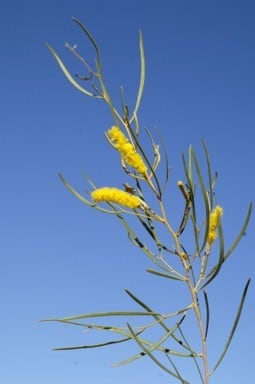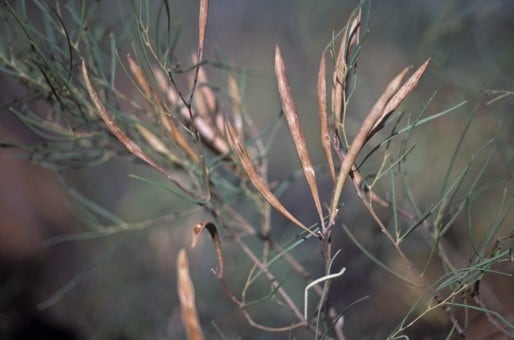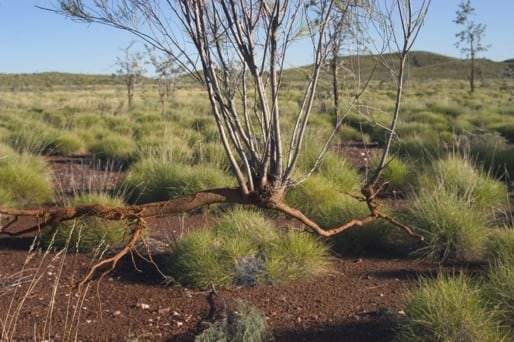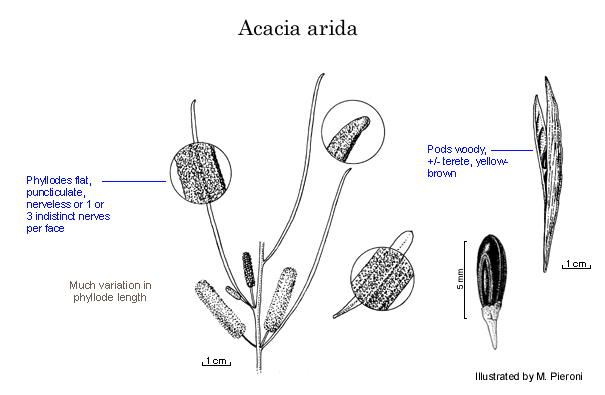Acacia arida Benth.
WATTLE
Acacias of Australia
Common Name
False Melaleuca, Arid Wattle
Family
Fabaceae
Distribution
Occurs in tropical W.A., in the Kimberleys and adjacent coast to the north and in the Roebourne–Exmouth Gulf–Mt Newman–Paterson Ra. area.
Description
Obconic, multi-stemmed, glabrous shrub 0.5–2 (–3) m high, crown dense with soft, delicate foliage. Branchlets light brown but reddish brown or yellowish at extremities, often with a thin ±waxy finely cracked resinous coating, obscurely ribbed. Phyllodes linear to narrowly oblong or linear-oblanceolate, erect, flat, ±straight, (2–) 2.5–6 (–8) cm long, 1–4 (–6) mm wide, coriaceous, puncticulate by evident (x10 mag.) stomata, light green (at least when young) to distinctly sub-glaucous or grey-green, with a sweet fragrant smell when young; nerveless or with an obscure central nerve, occasionally with 1 or 2 less prominent additional longitudinal nerves; gland 1, inconspicuous, 0.2–2 mm above pulvinus. Spikes 1–2.4 cm long, golden. Flowers 5-merous; calyx gamosepalous, dissected to 1/4–5/6. Pods erect, linear-oblanceolate, terete to flat or ±quadrangular, (3–) 4–6.5 (–8) cm long, woody, obscurely longitudinally striate, resinous, opening elastically from apex (dehisced valves shallowly to strongly recurved); margins inconspicuous; seed-partitions distinct but narrow. Seeds retained in pods following dehiscence, oblique and seated in distinct chambers, narrowly oblong-elliptic, 4.5–7 mm long, brownish black; funicle-aril narrowly turbinate.
Phenology
Flowers (often sporadically) Feb.–Nov., main flush May–Aug.
Habitat
Grows in red sandy loam or coarse, gravelly, skeletal sand on laterite or sandstone, in low, open eucalypt forest.
Specimens
W.A.: Wittenoom Gorge, B.Maloney 19/69 (NSW); 3.5 km W of Whim Ck on NW Coastal Hwy to Roebourne, B.R.Maslin 5797 (NSW, PERTH); Cape Ra. Natl Park, R.Pullen 10953 (CANB, NSW); 65 miles [104 km] S of Kalumburu Mission, North Kimberleys, N.H.Speck 4972 (CANB, NSW).
Notes
Acacia arida is very closely related to A. orthocarpa which is most readily, and perhaps arbitrarily, distinguished by its terete to subterete phyllodes: the relationship between these two species requires further study. A specimen collected by M.Lazarides 6392 (CANB, NSW), 19.2 km NNW of Elgie Cliffs Stn, Kimberleys, is intermediate between the two. In the Pilbara region, W.A., A. arida is generally a low, multi-stemmed shrub with a dense crown and appears to spread vegetatively by subterranean runners and regenerates from a basal root stock following fire. Acacia orthocarpa on the other hand is commonly a taller, single or few-stemmed plant with an open wispy crown and is normally killed by fire, regenerating from seed. Acacia arida probably also has affinities to A. arrecta. A possible hybrid between A. arida and A. stellaticeps has been collected in the Roebourne–Wickham area of W.A. (K.Glennon 196, PERTH). A rare hybrid between A. arida and A. ancistrocarpa has been recorded from near Roebourne (B.R.Maslin 8629, PERTH)
FOA Reference
Data derived from Flora of Australia Volumes 11A (2001), 11B (2001) and 12 (1998), products of ABRS, ©Commonwealth of Australia
Author
Dr M.D.Tindale and Dr P.G.Kodela with the assistance of M.Bedward, S.J.Davies, C.Herscovitch, D.A.Keith and/or D.A.Morrison
Edited by B.R.Maslin
This identification key and fact sheets are available as a mobile application:
URL: https://apps.lucidcentral.org/wattle/
© Copyright 2018. All rights reserved.














